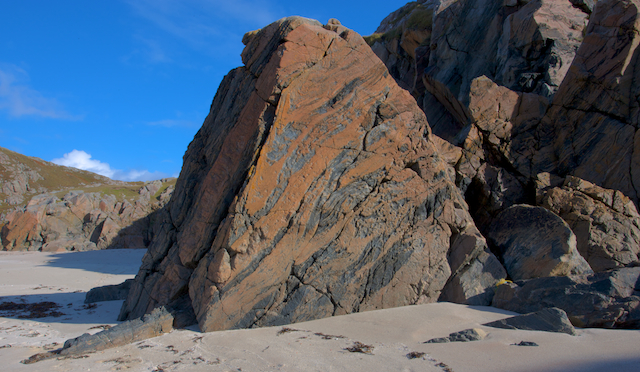On a holiday in 2008 to the
NW Highlands Geopark I had the opportunity to view the Lewisian Gneiss Complex that represented part of the Earths lower crust and the oldest dated rock in the Lewisian Gneiss complex is just over 3 Billion years old, a vast depth of time even by the standards of
geologic time.
 |
| Lewisian Gneiss |
The literature I had read beforehand was aimed at the general reader and hinted at the nature of the geology, but didn't quite prepare me for the actual field exposures. Most of the rocks I had seen up until then were of igneous, volcanic and sedimentary origin, deposited on the surface or at a high level in the continental crust, at a low grade of
metamorphism and relatively undeformed. Some of the rocks of the Lewisian Gneiss Complex have undergone episodes of high grade metamorphism and intense deformation, to produce a distinctive and perplexing rock. To make sense of it requires an appreciation of the heat and forces that the rock has been subjected to.
 |
Granite sheets intruding mafic gneiss and subjected to deformation in a tectonothermal event.
|
There is unanimous consensus amongst geologists that pressure and temperature increases with depth in the Earth and that mechanical properties of rock progressively changes with depth in the crust, from brittle to ductile and finally molten. Rocks buried deep in the earth, behave more like
plasticine than those at the surface. Fig 1 is an illustration of a simplistic high grade deformation of a rock body intruded by plutonic rocks and then subjected to progressive higher grades of deformation in a single episode. A ~ original relationships. B, C and D ~ increasing deformation or strain. To get to D requires a surprisingly large dimension image files in photoshop to simulate the strain to generate
Gneiss banding.
 |
| Figure 1 Simulation of the intense strain to deform rock into Gneiss |
Gneiss is the name given to a metamorphic rock that has undergone intense deformation at high temperatures and pressures. Fig 2 illustrates how previous deformation events can be overprinted by an event the causes intense deformation.
 |
| Fig 2 - Intense deformation overprinting previous deformation events |
Rocks that are several billion years old have unsurprisingly undergone several deformation events at high temperature and pressure (tectonothermal events). The banding in gneiss allows relict structures to be preserved in areas of relatively low strain and provide an insight into the geological history. Fig 3 A is a block of banded gneiss. B is a deformation event inducing structural folds with vertical axes. C is a deformation event causing a fold with a horizontal axis. D and E represent progressive deformation. F is a detail of the
recumbent isoclinal folds
 |
| Fig 3 - Deformation of banded gneiss and relict structure |
 |
| Recumbent folds in Lewisian Gneiss |
 |
| Lewisian Gneiss terrain and cross cutting pegmatite dykes. Note figure for scale. |
 |
| Illustrated cross cutting pegmatite dykes |
 |
| Cross cutting relationships detail - Gneiss cut by pegmatite dyke and then both are cut by a 2nd (pink) pegmatite dyke |
 |
| Highly inclined in-weathered Scourie Dyke cutting through Lewisian Gneiss |
 |
| Illustrative interpretation of in-weathered Scourie Dyke cutting Lewisian Gneiss |
In the late 19th Century, officers of the Great British Geological Survey started work mapping, recording, sampling and examining the petrology of the constituent rocks of the mainland Lewisian Gneiss Complex, to elucidate its history and nature. In 1907 a memoir titled
"The Geological Structure of the North West Highlands of Scotland" was published, that covered the observations and findings of some of Great Britain's most experienced and respected geologists.
 |
| Gneiss (Grey) intruded by Scourie Dyke (Black) then intruded by Granite (Pink) and deformed by tectonothermal event(s) |
The Geological Survey broke down the Lewisian Gneiss Complex into two divisions 1) Gneisses, the majority of which had affinities to plutonic igneous rocks with a wide range of petrological characteristics and a minority of presumed sedimentary rocks. 2) A great series of intrusive rocks that like the gneiss had a wide petrographical range. Intrusive rocks were used as markers to constrain deformation and mineral changes within the intrusive rocks and provided evidence and clues on the phenomenon of metamorphism.
 |
| Realtively low strain outcrop of Mafic gneiss (Dark) veined by Tonalite or Tondhjemite (white). Possibly a migmatite. |
The effects of earth movements and metamorphism were also recognised in the structure with planes of shear, folding and thrusts, by noting the changes in gneiss banding orientation, deformation of intrusive rocks, relict structures and changes in mineral assemblages. The deformation intensity was to some extent heterogenous and also varied in style through the districts.
 |
| Weathered exposure of gneiss with a refolded fold. |
Deformation and metamorphism were heterogenous in nature at all scales, it was observed that a rocks mineral assemblages could change across a hand specimen or even in a sample prepared for microscopic examination. The phenomena of changes in mineral assemblage of rock also seemed independent of deformation and gneisses with
pyroxene passed imperceptibly into
hornblende by the hornblende replacing pyroxene.
 |
| Highly inclined pegmatite sheet cutting moderately inclined gneiss |
Despite the great heterogeneity of rock petrology and deformation, the Lewisian Gneiss Complex was divided into 3 districts : North, Central and South, on the basis of each district having its own fairly distinct mineral assemblages and representative styles of structural deformation.
 |
| Granite sheets intruding mafic gneiss and isoclinally folded |
The fieldwork and petrological analysis by officers of the Geological Survey produced a solid foundation for geologists to continue further investigations into the geological processes that had acted upon the Lewisian Gneiss Complex. The next post will review some of the controversies the geological processes that have formed the Lewisian Gneiss Complex and its history.
















No comments:
Post a Comment